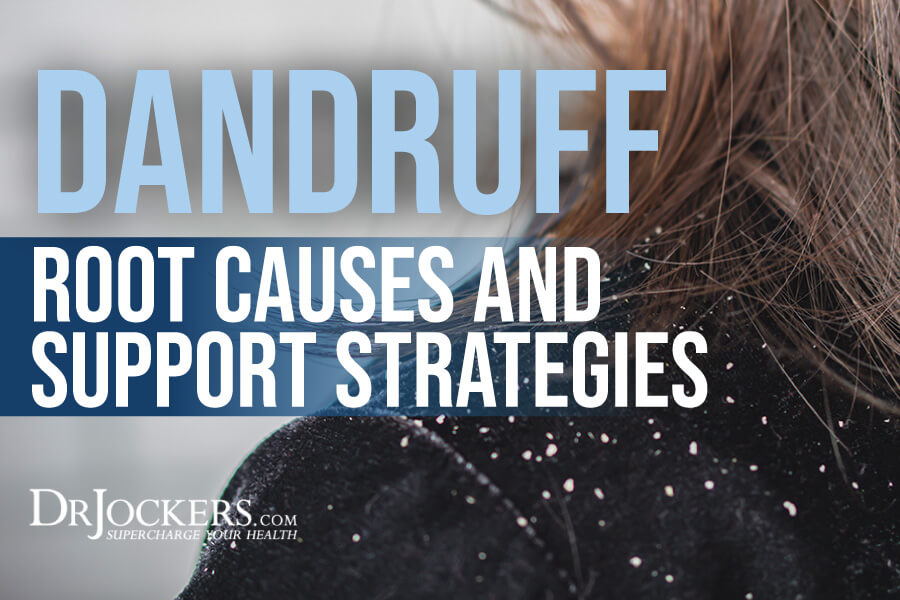 Dandruff: Root Causes and Support Strategies
Dandruff: Root Causes and Support Strategies
We all know dandruff. It’s white or yellow dry skin flaking off your scalp. The condition can be rather embarrassing, especially when it’s affecting a visible area or leaving visible flakes on your dark clothes. It can also be uncomfortable causing itching. The good news is that you don’t have to deal with the discomfort and embarrassment of dandruff anymore. There are some natural support strategies for dandruff that may improve your health.
In this article, you will learn what dandruff is and how it’s different from just dry skin. I will go over the signs and symptoms of dandruff. You will learn about different types of dandruff. I will explain the risk factors for dandruff. You will learn about conventional treatment options for dandruff. I will discuss the common root cause factors that may increase the risks and symptoms of dandruff. Finally, I will offer some natural support strategies for dandruff.
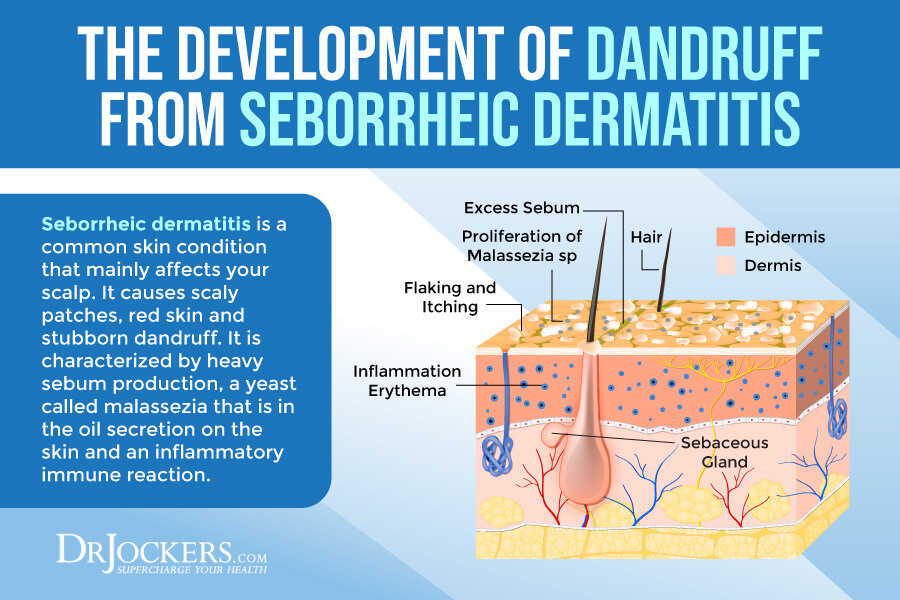
What is Dandruff
Dandruff is a common condition that affects your scalp. It is characterized by small pieces of dry skin that flake off your scalp. It provides a white powdery look and can be more noticeable if you have darker hair or wearing dark colors and the flakes land on your shoulders.
Dandruff is usually different from simply having a dry scalp. Having a dry scalp means that the skin on your head has too little moisture and gets irritated. Dry scalp may also start visibly flaking. Dry skin and dry scalp may develop from cold and dry air, contact dermatitis from shampoo, hair spray, or other hair products, or older age. If you have a dry scalp, your face, arms, legs, or other body parts may also have dry skin.
If you have dandruff for other reasons, it means that the skin cells on your scalp die quicker and shed more and quicker than they normally should. As skin cells renew, shedding old skin is normal. However, unless you have dandruff, it should not be too visible or cause issues. Dry skin dandruff and dandruff also look different. Dandruff from dry skin usually looks small and white. Dandruff flakes are generally larger and look more oily as well.

Pathophysiology of Dandruff
Dandruff may develop for many others reasons and the exact causes are not completely understood. According to a 2015 review published in the Journal of Clinical and Investigative Dermatology, dandruff often develops because of seborrheic dermatitis, a skin condition that causes oily, red, and scaly skin (1). This condition may affect your eyebrows, armpits, groin areas, or anywhere else you have oil glands. On your head, it causes white or yellow scales that we call dandruff when flaking off.
Another common trigger of dandruff is Malassezia, which is a fungus that affects your scalp and may cause your skin cells to multiply more quickly than normal. Your hormonal health, stress, age, and other factors may affect this fungus and trigger more dandruff.
The stratum corneum (SC) is the outermost layer of your epidermis made up of dead cells. According to a 2012 review published in the International Journal of Cosmetic Sciences, a healthy SC helps to maintain hydration and reduce water loss of your skin (2). It also serves as a barrier that protects your skin from chemical transfer through the skin, toxins, and harmful microorganisms, such as Malassezia.
If this barrier is chronically or seriously damaged, it can cause poor hydration, which can lead to a variety of issues, including atypical epidermal proliferation, keratinocyte differentiation, and SC maturation. It may also lead to inflammation and an increased risk of skin irritation from topicals. It may also increase the risk of susceptibility of Malassezia. These factors may explain the increased risk and symptoms of dandruff.
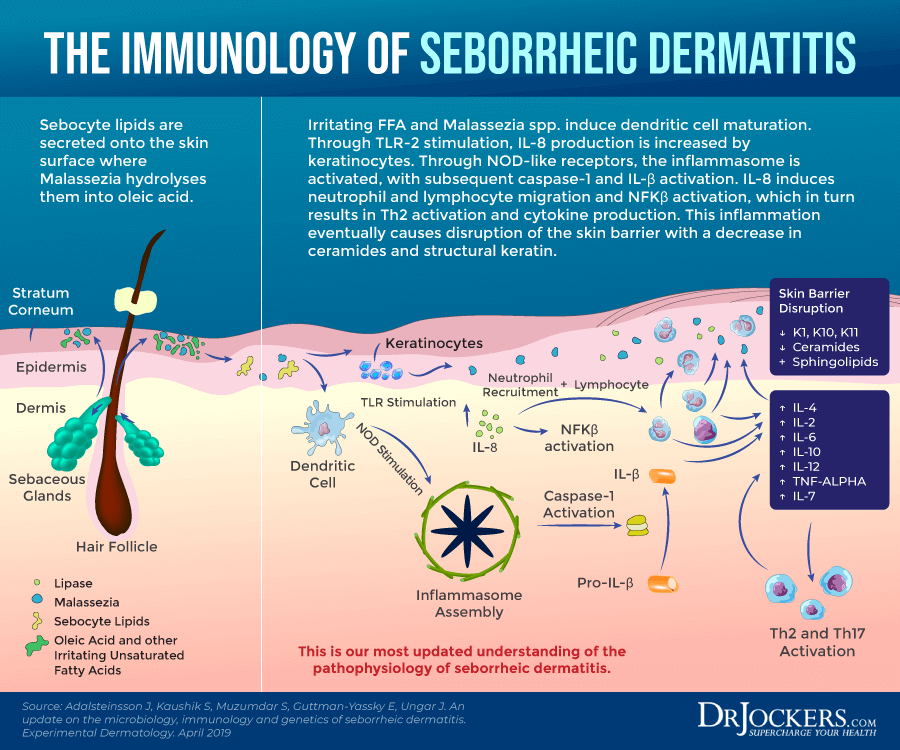
Signs & Symptoms of Dandruff
Signs and symptoms of dandruff may include:
- Larger, oily white or yellow flakes
- Itchy scalp
- Oily, red, or scaly scalp
- In severe cases, inflammation, red, or yellowish raised bumps of the skin along the hairline
Types of Dandruff
There are four main different types of dandruff that you need to know about. Each presents a unique case and requires the right treatment strategy.
Dry Skin Dandruff
Dry skin dandruff happens if your scalp is too dry, becomes irritated, and starts to shed dry skin cells. The flakes tend to be mostly small and white. Dry skin dandruff may cause itching as well.
It is the most common during the wintertime when the weather is cold outside but the indoor air is dry from heating. Dry skin dandruff usually becomes manageable with the help of some moisturizing, such as coconut oil scalp massage and moisturizing shampoo.
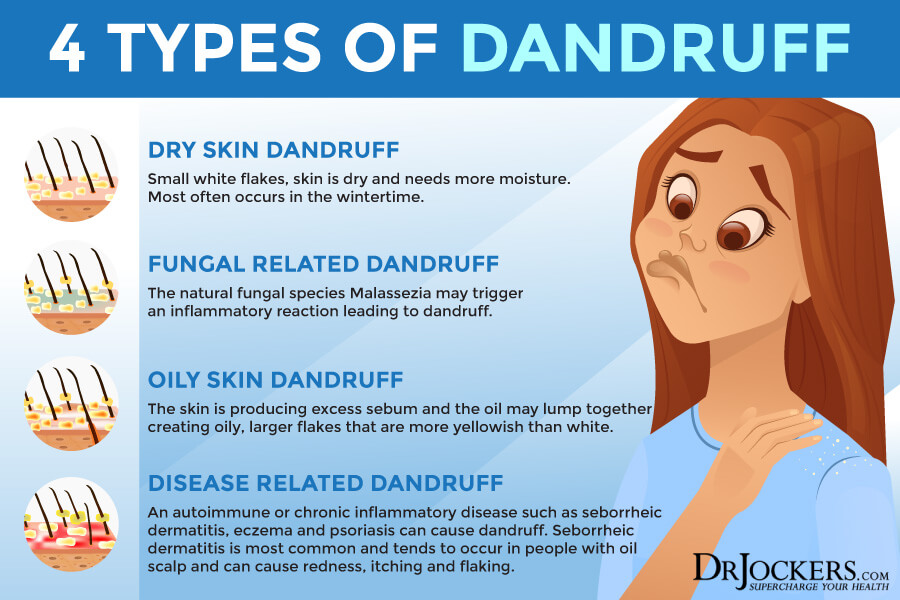
Oily Skin Dandruff
Under the surface of your skin, there are glands that produce an oily substance. It’s called sebum. Your body creates it to moisturize and protect your skin. However, if your scalp is producing too much sebum and your hair becomes oily, it can lead to dandruff.
The extra oil on your scalp can accumulate and lump together creating oily, larger flakes that usually look yellowish rather than white. Seborrheic dermatitis can cause oil skin dandruff as well. Treatment usually involves getting the oiliness in control.
Fungus-Related Dandruff
I have already mentioned that a common cause of dandruff is a fungus called Malassezia. This fungus is actually found on the skin of every person. However, in some people, it can become problematic and can trigger inflammation and seborrheic dermatitis.
This inflammatory response may cause dandruff and other skin problems, including eczema. According to a 2018 review published in the International Journal of Trichology, treatment may involve special shampoo for eczema, seborrheic dermatitis, or psoriasis, made with zinc pyrithione (3). Tea tree oil or shampoo with tea tree oil may also help.
Disease-Related Dandruff
You may also develop dandruff due to a skin condition. Seborrheic dermatitis, eczema, and psoriasis are common culprits behind dandruff. Seborrheic dermatitis is common in people with oily scalp. It may cause redness, itching, and flaking. Eczema or atopic dermatitis is an inflammatory skin condition that can also cause redness, rashes, itching, and flakiness.
Psoriasis is an autoimmune condition where your skin cells produce and grow too quickly. This leads to thick, dry, and scaly patches. According to the National Psoriasis Foundation, between 45 and 56 percent of people with psoriasis also experience scalp psoriasis (4). Scalp psoriasis can cause a white build-up of dead skin cells, inflammation, scaling, and disease-related dandruff. In the case of disease-related dandruff, you have to address the underlying skin condition to get dandruff under control.
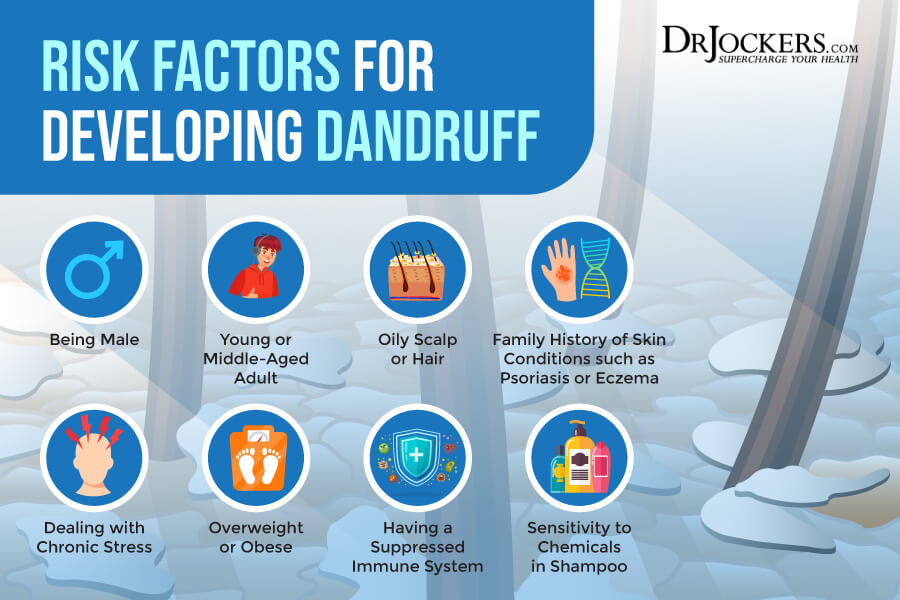
Risk Factors for Dandruff
Dandruff may affect anyone at any age, however, certain factors may increase your risk. Risk factors for developing dandruff may include:
- Being male
- Being young to middle-aged adult
- Having oily scalp and oily hair
- Dealing with excessive or chronic stress
- Having a suppressed immune system, including from HIV/AIDS, hepatitis C, or organ transplant
- Deficiencies in zinc, vitamin D, B vitamins, or certain fats, or not eating enough of these nutrients
- Having an eating disorder
- Having or having a family history of autoimmune or inflammatory skin conditions, such as psoriasis and eczema
- Having a neurological disease, such as Parkinson’s disease or Alzheimer’s disease
- Being in recovery from a recent stroke or heart attack
- Being obese
- Sensitivities to chemicals or other ingredients of shampoo and other hair, scalp, and skin products
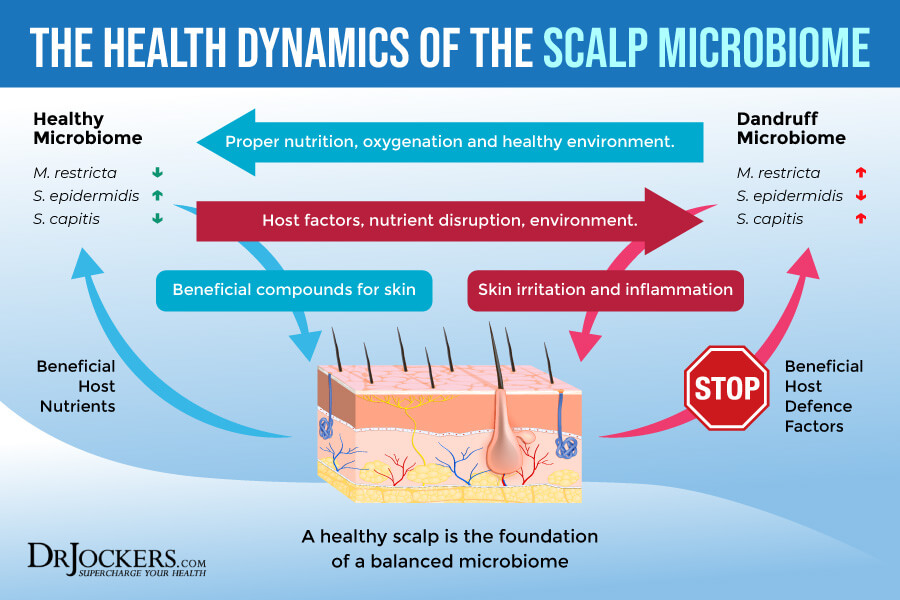
Conventional Treatment Options
Dandruff is often a chronic condition, however, it is treatable. Conventional treatment options may include gentle over-the-counter (OCT) shampoo that may help to reduce oily skin and skin cell buildup or OCT dandruff shampoo specifically designed for dandruff. The active ingredients of OCT dandruff shampoo may include zinc pyrithione (antifungal and antibacterial), selenium sulfide (antifungal), tar-based ingredients (antifungal and antibiotic), ketoconazole (antifungal), or salicylic acid (to remove flakes) (5).
When OTC dandruff shampoo doesn’t reduce dandruff after several weeks or a month of use, your dermatologist may recommend a prescription-strength anti-fungal shampoo, corticosteroid lotion, or calcineurin inhibitors to suppress the immune response.
To reduce and relieve your symptoms, your dermatologist may also offer some drug-free recommendations, including shampoo or topicals with tea tree oil, increasing omega-3 fatty acids and other healthy fats in your diet to help regulate the oil production of your scalp, reducing the use of triggering hair products, and getting some sunshine to decrease yeast production of the skin on your scalp (6).
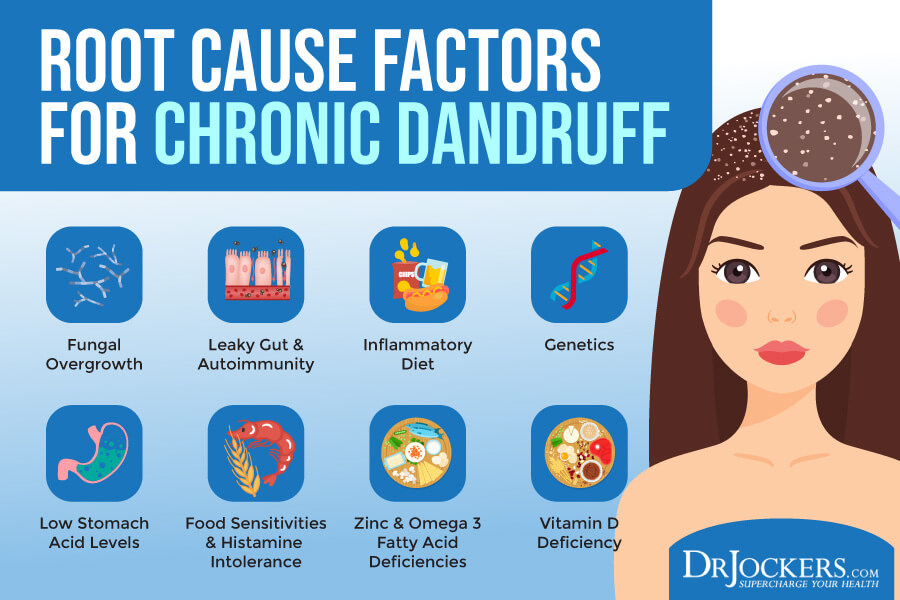
Root Cause Factors
Understanding your risk factors and symptoms is important. However, to truly address your condition, we have to understand the root cause factors that may increase your risk, contribute to, or worsen your dandruff. Here are the main root cause factors for dandruff:
Genetics
One of the major root cause factors of dandruff that may increase your risk of developing this condition is genetics. A 2012 randomized controlled trial published in the British Journal of Dermatology has looked at the gene expression profiles of participants with and without dandruff and compared them (7). The same study has also the effectiveness of zinc pyrithione shampoo for dandruff and found it to be a potentially effective treatment option.
According to a 2021 article published in Bio Essays, genetic scientists have discovered 487 genetic markers associated with dandruff (8). Researchers found that genetic variations may affect inflammatory genes, inflammation levels, lipid metabolism, immune response, cell proliferation, apoptosis, epidermal development and health, and response to stimulus (7).
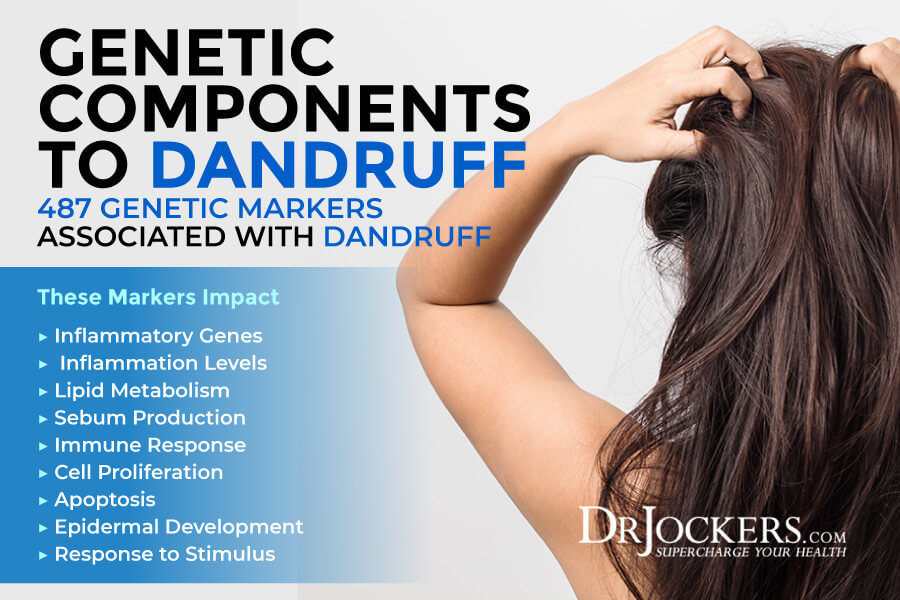
Inflammatory Diet
Following an inflammatory diet will lead to, no surprise, chronic inflammation. On the other hand, an antioxidant-rich, anti-inflammatory diet, may help to control chronic inflammation. An inflammatory diet high in sugar, starches, inflammatory omega-6 fatty acids, refined vegetable oils, and processed foods can increase chronic inflammation.
Inflammation may reduce your natural response to allergic reactions or skin injuries. It may also cause swelling, rashes, itching, and pain. Sugar and starches may also trigger the overproduction of sebum and increase the oiliness of your skin. Sugar and starches may also feed yeast and fungus and increase fungus-related dandruff. According to a 2019 study published in the Journal of Investigative Dermatology, inflammatory foods may also increase seborrheic dermatitis, which may cause dandruff (9).

Leaky Gut & Autoimmunity
A 2019 review published in Microorganisms has found that there is a connection between your gut health and your skin health (10). Gut microbiome issues are a common cause of skin problems, including dandruff. A 2021 review published in Microorganisms has explained the gut-skin axis, which is the interrelationship between your skin and gut (11). They found that gut microbiome imbalances may cause dandruff, psoriasis, dermatitis, acne, and other skin issues (11).
A 2020 review published in Nutrients has found that gut microbiome imbalance and leaky gut syndrome can go hand in hand (12). According to a 2020 review published in the International Journal of Molecular Sciences, leaky gut may lead to autoimmunity (13). Autoimmunity may lead to dandruff in some cases. Psoriasis is an autoimmune condition that may lead to dandruff. According to a 2016 review published in Psoriasis (Auckland), scalp psoriasis may cause dandruff (14).
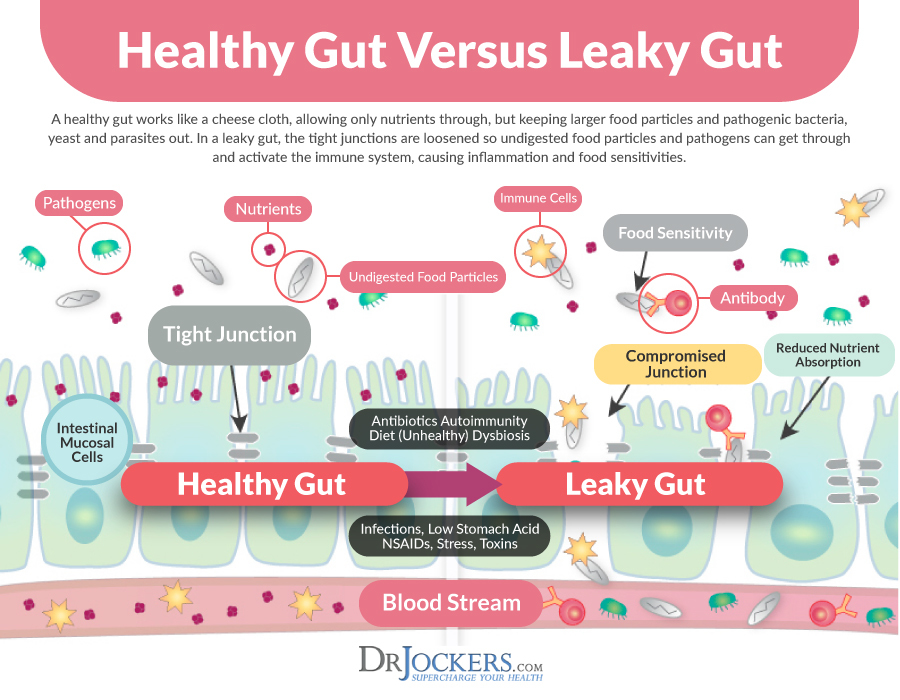
Fungal Overgrowth
A 2019 review published in Microorganisms and a 2021 review published in Microorganisms have both found that there is a connection between your gut microbiome health and your skin health (10, 11). Researchers found that gut microbiome imbalances may cause dandruff, psoriasis, dermatitis, acne, and other skin issues (11). One of the major causes of gut microbiome and skin microbiome imbalance may be fungal overgrowth.
According to a 2017 review published in the European Journal of Dermatology, fungal skin microbiota may increase the risk of dandruff and seborrheic dermatitis (15). According to a 2012 review published in the International Journal of Cosmetic Sciences, Malassezia overgrowth is a common reason behind dandruff (2). A 2014 study published in the Indian Journal of Medical Research has also found a link between Malassezia and dandruff (16).

Low Stomach Acid Levels
A 2019 review published in Microorganisms and a 2021 review published in Microorganisms have both found that there is a connection between your gut microbiome health and your skin health (10, 11). Beyond poor microbiome balance and leaky gut syndrome, low stomach acid levels may contribute to dandruff and other skin issues.
Hydrochloric acid or HCL is critical for your digestion and overall health. Bacterial infections, inflammation, acid-blocking medications, and other health imbalances may cause low stomach acid levels. A 2018 review published in Frontiers in Microbiology, low stomach acid levels may cause inflammation of the skin and related skin issues, such as psoriasis, eczema, acne, and dandruff (18).

Food Sensitivities and Histamine Intolerance
Food allergies cause immediate reactions, usually, hives, tingling, wheezing, swelling, redness, or difficulty breathing. Food sensitivities, on the other hand, lead to delayed reactions that develop overtime hours or days after eating a certain food. Food sensitivities can lead to chronic inflammation and chronic symptoms. Skin problems, including dandruff, are one of the most common symptoms of food sensitivities.
Histamine is a chemical in your body. It is responsible for a number of bodily functions, including getting rid of allergens, triggering stomach acid release, and supporting brain health. It affects all parts of your body, including your gut, brain, lungs, and cardiovascular system. Histamine is an essential chemical, but if there is too much histamine in your body, it can become a problem (18). Too many high-histamine foods, stress, infections, inflammation, may lead to a histamine build-up called histamine intolerance.
Histamine intolerance may cause a variety of symptoms, including skin problems, digestive issues, headaches, migraines, blood pressure issues, racing heart rate, anxiety, seasonal allergies, sleep disturbances, and bladder problems. Dandruff is very common in those with histamine intolerance. A 2011 randomized controlled trial published in Acta Verna-Dermatologica has found that histamine intolerance was twice more common in those with dandruff than those without (19).
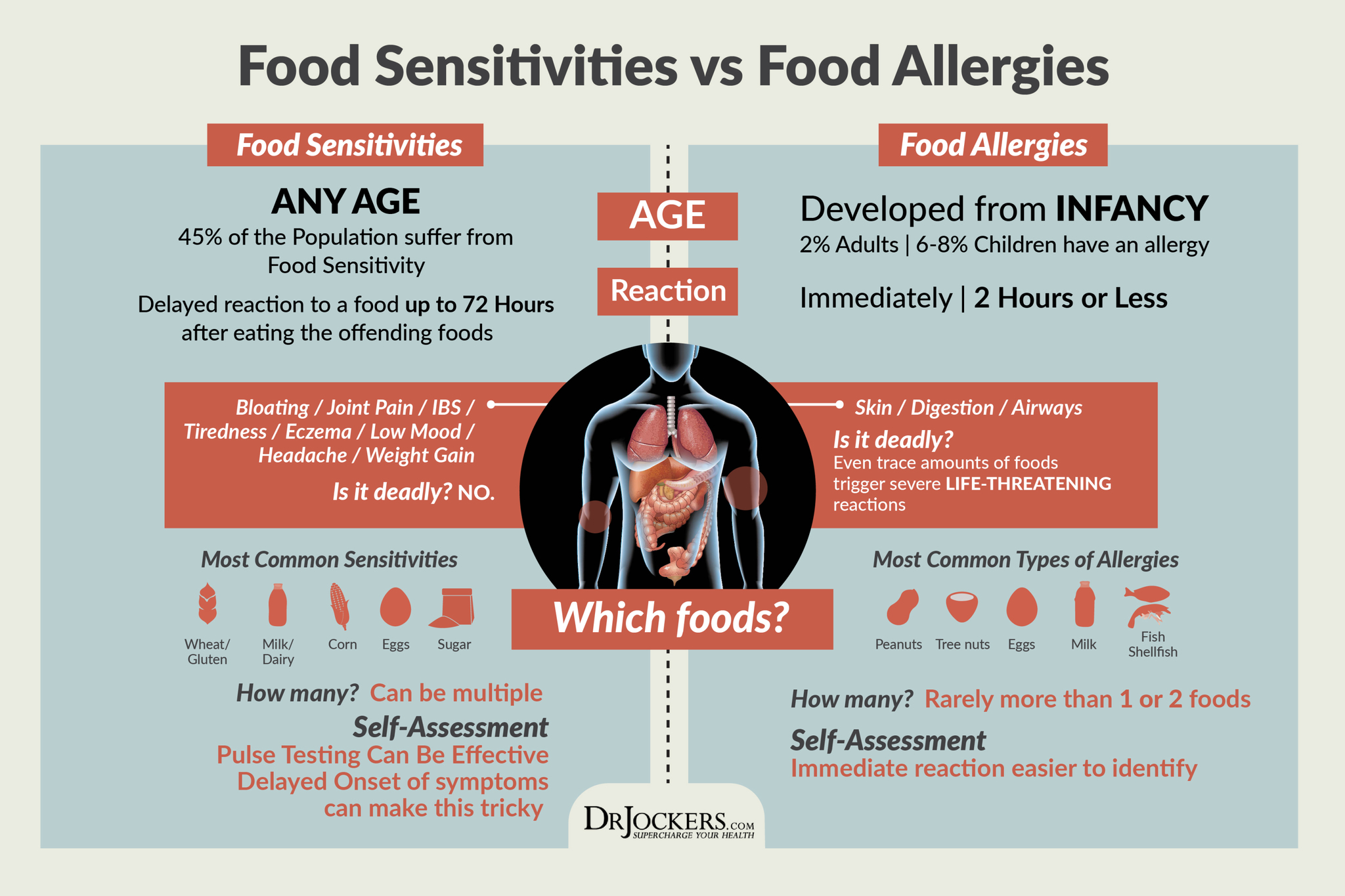
Vitamin D Deficiency
Vitamin D is a vital vitamin. It’s essential for your immune, bone, muscle, skin, and brain health. Your body makes vitamin D when the UV rays of the sun penetrate your skin. However, due to our indoor lifestyle and gloomy, cold weather, meeting your vitamin D needs alone is difficult or impossible.
Some foods, such as egg yolk, beef liver, and fish, contain vitamin D, however, it’s still not enough to meet your needs. Vitamin D deficiencies are incredibly common, especially if you are not supplementing. Vitamin D deficiency may lead to a number of health issues, including skin problems.
A 1988 study published in World Review in Nutrition and Dietetics has found that there are a variety of nutrient deficiencies that may play a role in some of the major causes of dandruff, seborrheic dermatitis and psoriasis, including vitamin D deficiency (20). A 2017 article published in Current Advanced Research has found that taking 1600 IU of vitamin D (cholecalciferol) per day for 3 months has helped to improve symptoms and reduce flare-ups of seborrheic dermatitis in affected participants (21). A 2021 case-control study published in Dermatology Research and Practice has also found that low vitamin D levels may play a role in dandruff and improving vitamin D levels may help to improve the condition (22).

Zinc Deficiency
Zinc is an incredibly important mineral for your immune function, metabolism, and other areas of your health. It is also important for your skin health. Unfortunately, zinc deficiencies are quite common and may lead to a list of health concerns, including skin issues and dandruff.
A 1988 study published in World Review in Nutrition and Dietetics has found that there are a variety of nutrient deficiencies that may play a role in some of the major causes of dandruff, seborrheic dermatitis and psoriasis, including zinc deficiency (20). A 2006 review published in the Journal of Dermatological Treatment has found that zinc deficiency may be connected to a variety of skin conditions, including dandruff (23).
Researchers found that zinc may be a beneficial treatment option. A 2019 case-control study published in the Turkish Journal of Medical Sciences has also found that zinc deficiency is common in those with seborrheic dermatitis, a common cause of dandruff (24).
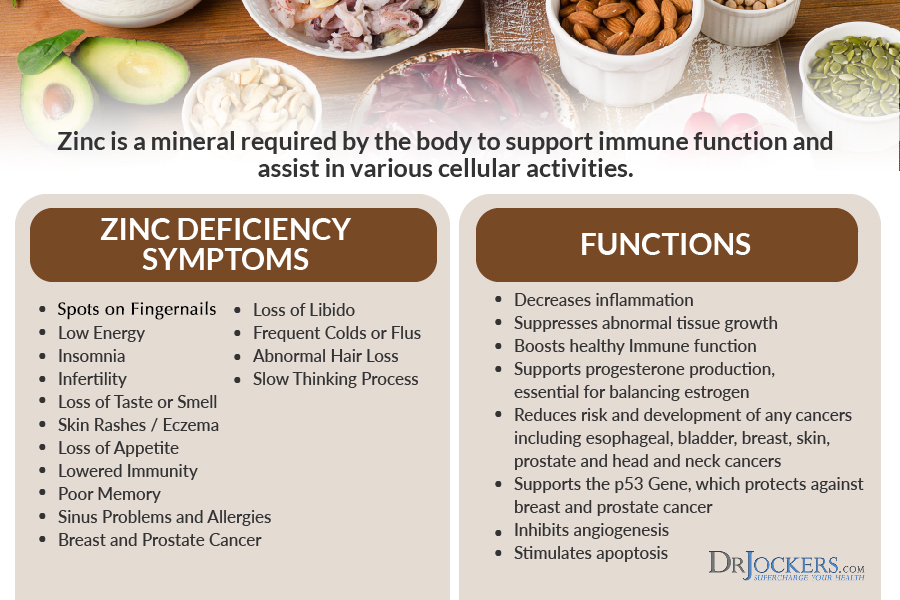
Natural Support Strategies
If you want to address dandruff effectively, you have to address the root cause factors of your condition. Conventional treatment strategies for dandruff often only address the symptoms. They may also come with risks and side effects that may not be the best for your overall health.
Fortunately, you can address the root cause factors of dandruff naturally and reduce your symptoms effectively without risks and side effects. Here are the natural support strategies I recommend for dandruff:
Anti-Inflammatory Nutrition Plan
According to a 2019 study published in the Journal of Investigative Dermatology, an inflammatory diet may contribute to dandruff (9). Following an anti-inflammatory nutrition plant with anti-inflammatory, antioxidant-rich, and nutrient-dense whole foods may help to reduce your symptoms.
Remove inflammatory, including refined sugar, starchy food, gluten, refined oils, deep-fried foods, additives, artificial ingredients, conventional dairy, junk food, and highly processed food. Decrease exposure to pesticides, herbicides, hormones, and other toxins by choosing organic foods whenever possible. Instead, choose a nutrient-dense nutrition plan rich in anti-inflammatory foods, including greens, vegetables, sprouts, herbs, spices, low-glycemic index fruits, fermented food, mushrooms, grass-fed beef, pasture-raised poultry and butter, wild-caught fish and seafood, and wild game.
Eat plenty of healthy fats, such as good fats, such as avocados, coconut oil, grass-fed ghee or butter, olives, and extra virgin olive oil to support the regulation of oil production. Eat plenty of foods rich in anti-inflammatory omega-3 fatty acids, including wild-caught fish, flaxseeds, chia seeds, and hemp seeds.
Add anti-inflammatory herbs and medicinal foods, such as ginger, turmeric, cinnamon, chili, cayenne, and black pepper, rosemary, cloves, and raw honey to your diet. Consume plenty of foods that are rich in antioxidants, including blueberries, strawberries, raspberries, blackberries, kale, artichokes, raw cacao, cilantro, pecans, and walnuts. You can learn more about an anti-inflammatory diet to support your skin health here.

Remove Food Sensitivities
Food sensitivities may lead to dandruff and other skin problems. Removing food sensitivities is critical. First, you need to identify your food sensitivities. Common food sensitivities include sugar, gluten, wheat, eggs, dairy, legumes, soy, and shellfish. However, you may have other, less common, food sensitivities.
There are various blood tests to check for food sensitivities. It’s not enough though. These tests only look for certain common sensitivities, and false results are not unusual. Blood tests may be a great first step, but you may need to dig deeper to identify your own sensitivities. I recommend that you first identify your personal food sensitivities with the combination of some blood tests, pulse testing, muscle testing, and an elimination diet.
Once you have identified your triggers, remove them from your diet. Since refined sugar, refined oil, and gluten are highly inflammatory, I recommend removing them regardless of your food sensitivity results. Since food sensitivities can change over time, I recommend testing yearly or if you notice new symptoms.

Consider a Low Histamine Diet
According to a 2011 randomized controlled trial published in Acta Verna-Dermatologica, histamine intolerance was twice more common in those with dandruff than those without (19). Reducing your histamine levels with the help of a low-histamine diet may help to get your dandruff under control.
Remove high-histamine foods from your diet for at least a month or until you have your symptoms under control and you feel better. High-histamine foods include avocados, tomatoes, bananas, strawberries, dried fruits, most citrus, eggplant, spinach, vinegar, vinegar-containing foods, cashews, walnuts, peanuts, fermented foods, cheeses, smoked fish, cured meat, many spices, processed foods, and leftovers.
Once you feel better, you can start re-introducing higher histamine foods at limited amounts depending on how you tolerate them. However, even after re-introduction, keep high-histamine foods in your diet low to avoid histamine intolerance issues in the future.
Beyond foods, other factors may also increase histamine intolerance. These factors may include chronic stress, toxins, environmental issues, and gut health issues. It is important that you address these health and lifestyle factors as well beyond your diet. Reduce your stress levels, get 7 to 9 hours of restorative sleep each night, move your body regularly, reduce your exposure to environmental toxins, and address underlying gut health problems. You may learn more about histamine intolerance and what to do about it by reading this article.

Improve Stomach Acid Levels
A 2018 review published in Frontiers in Microbiology, low stomach acid levels may cause skin inflammation of the skin and related skin issues (18). This may cause dandruff. Improving your stomach acid levels may help.
Start by following an anti-inflammatory and gut-friendly diet as I outlined earlier. You may want to try a liquid nutrition plan or partial liquid nutrition plan for a few weeks until your stomach acid levels and gut improve. Following a liquid nutrition plan means that at least half of your meals have to be in a liquid form, such as protein shakes or green smoothies.
Protein shakes are pre-metabolized. They are incredibly easy to digest and do not depend upon HCL production. If you have low stomach acid levels, it may be beneficial to drink one to two protein shakes a day to support amino acid absorption, reduce extra stress on your digestion, and support healthy stomach acid levels.
I recommend that you always begin your meals with protein first. Since it is culturally common to have a salad before their protein dish, this may be odd at first. But starting with greens and fiber before protein is not great for your HCL production. It is a much better idea to eat your protein before or with the salad or vegetables instead of after.
For optimal stomach acid levels, I recommend that you eat your largest meals when you are the most relaxed. This may be at lunch or may be at dinner depending on your schedule. Your body needs to activate the parasympathetic nervous system to produce enough stomach acids. If you are busy and on the go, you will be in fight or flight sympathetic mode. If you struggle with low stomach acid, this fight or flight state will not allow your body to produce anywhere near enough. Relaxing before the meal is important to improve stomach acid production.
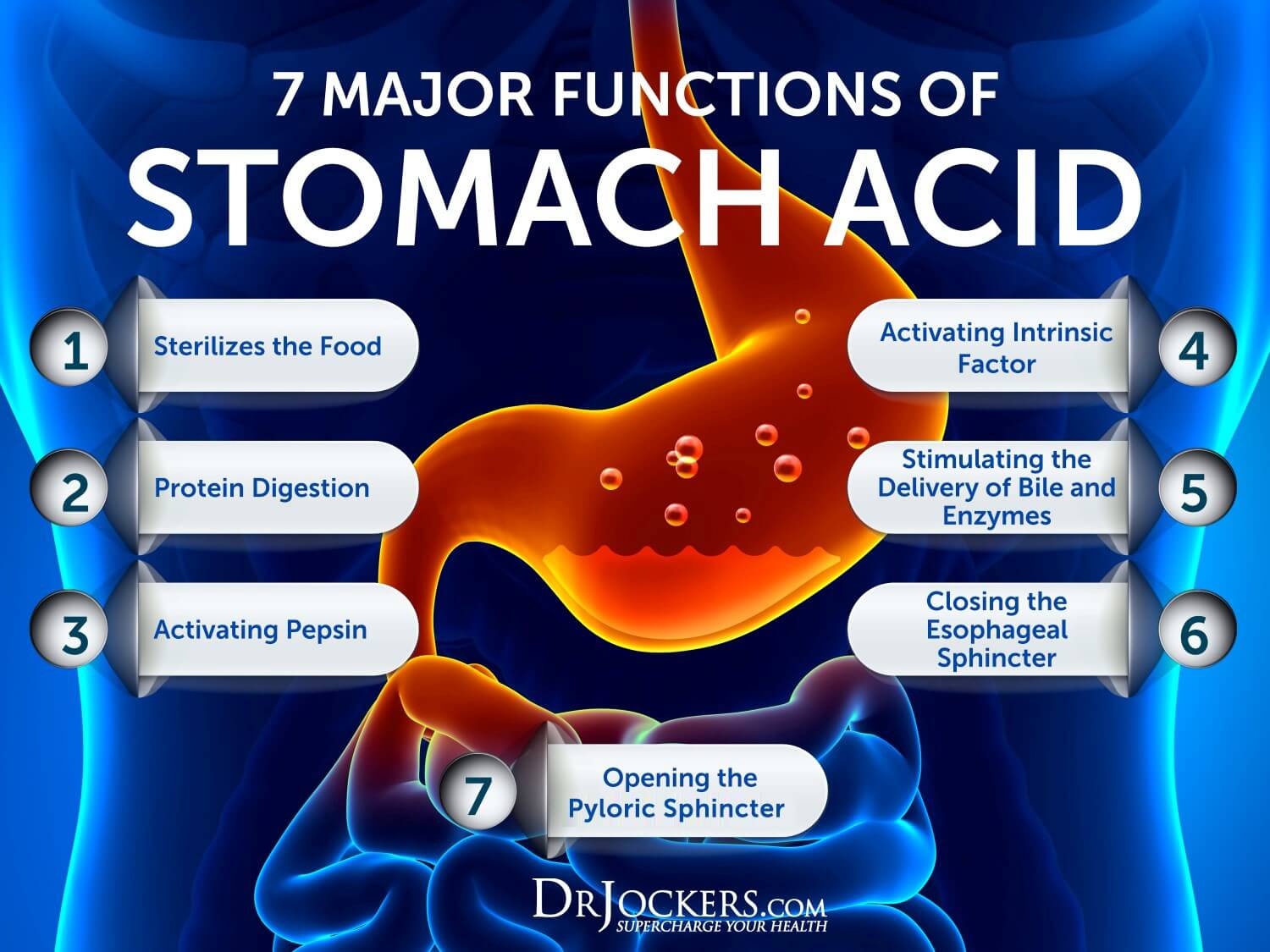
I recommend that you add fermented foods, such as sauerkraut, kimchi, pickles, pickled ginger, and other fermented vegetables. They contain organic acids, enzymes, and probiotics which help to improve digestive juice secretions.
I also recommend fermented drinks, such as apple cider vinegar, coconut kefir, and kombucha with anti-microbial benefits to help to reduce the bacterial load, especially the bacteria in the stomach such as H Pylori. Additionally, take daily probiotic supplements to support your microbiome health, digestive enzymes to support digestion, and a supplement with betaine hydrochloric acid to support stomach acid production and bile flow.
There is one exception to this recommendation. If you are dealing with histamine intolerance. Fermented foods can trigger histamine intolerance, so if it’s part of your problem, it’s better to stay away from it. If you have histamine intolerance, you also need to make sure to choose probiotics for histamine intolerance. Avoid strains like Lactobacillus casei and Lactobacillus bulgaricus.
Eat slowly and chew your food well. Hydrate well throughout the day between meals to help activate bowel motility and push contents through the digestive system, which will reduce microbial fermentation and toxicity in the body. However, stop drinking water or other liquids at least 30 minutes before the meal, except if you need to take a supplement with 2 ounces of water and don’t drink water or other liquids until at least 30 minutes after a meal. This allows for proper stomach acid activity, sterilization, and protein metabolism.
For better digestion and improved stomach acid levels, I recommend using ginger in your meals and adding ginger to your tea. Ginger is one of the best things for improving digestive juices. I recommend drinking 2 to 3 cups of ginger tea each day. You can put ginger essential oil in water (2 to 3 drops in 8 oz of water), juice a ½ inch of fresh ginger root in a green juice each day, and use ground ginger on your foods. You can also add fermented ginger to your diet, which is common in Asian dishes such as kimchi.
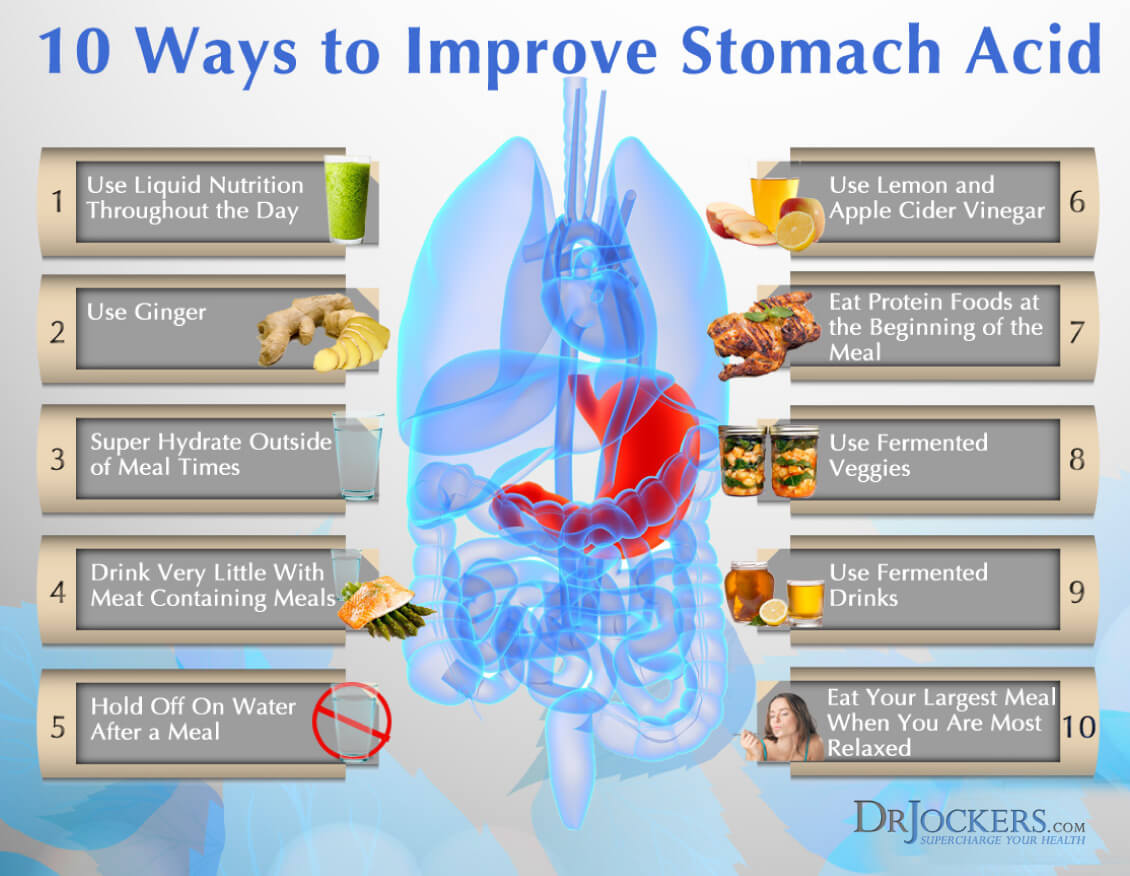
Support the Gut Microbiome
A 2019 review published in Microorganisms and a 2021 review published in Microorganisms have both found that there is a connection between your gut microbiome health and your skin health (10, 11). To support your digestion and microbiome health, I recommend taking probiotics. I also recommend consuming probiotic-rich, fermented foods, such as sauerkraut, kimchi, fermented vegetables, fermented herbs, coconut kefir, coconut yogurt, and kombucha, unless you have histamine intolerance. Fermented foods are high in histamine and can be highly triggering if you have histamine intolerance, so you should stay away from them
You may also benefit from prebiotic-rich foods that feed these good bacteria from probiotics, such as Jerusalem artichokes, apples, jicama, garlic, onion, and leeks. However, prebiotics-rich foods can be triggering for certain people. They are not appropriate if you are on a low-FODMAP or carnivore diet. If you are on these diets or experiencing digestive issues, discomfort, or other symptoms, reduce or remove prebiotic foods.
Beyond supporting your gut microbiome, you can support your gut health in a few other ways. If you are struggling with constipation or irregular bowel movements, I recommend Bowel Mover as a herbal support for elimination. To support your digestion, I recommend taking digestive enzymes, such as Proteo Enzymes, before meals. I also recommend that you try Gut Repair for digestive support and gut health. To support detoxification, you may want to try Activated Charcoal and HM-ET Binder to remove toxins from your gut.

Optimize Vitamin D Levels
A 1988 study published in World Review in Nutrition and Dietetics, a 2017 article published in Current Advanced Research, and a 2021 case-control study published in Dermatology Research and Practice have all found that low vitamin D levels may play a role in dandruff and improving vitamin D levels may help to improve the condition (20, 21, 22).
To optimize your vitamin D levels, spend time in the sun and consume vitamin D-rich fatty fish, egg yolks, and beef liver. However, sunshine and food are not enough to ensure optimum vitamin D levels. I recommend daily supplementation with vitamin D3.
Pairing vitamin D3 with vitamin K2 helps improve calcium absorption and inflammation control. I recommend taking a vitamin D3 supplement with at least 3,000-5,000 IU’s of vitamin D3 and at least 90 mcg of vitamin K2. I highly recommend Vitamin D3/K2 Power. Both of these supplements support your immune, skin, cardiovascular, and bone health.
Typically, taking 1,000 IU per 25 lbs. of body weight will help you get your levels into a healthy range. You want to test your vitamin D levels at least 1-2 times each year and get your levels between 50-100 ng/ml. It has been hypothesized that a therapeutic level for major health conditions is going to be between 70-100 ng/ml.
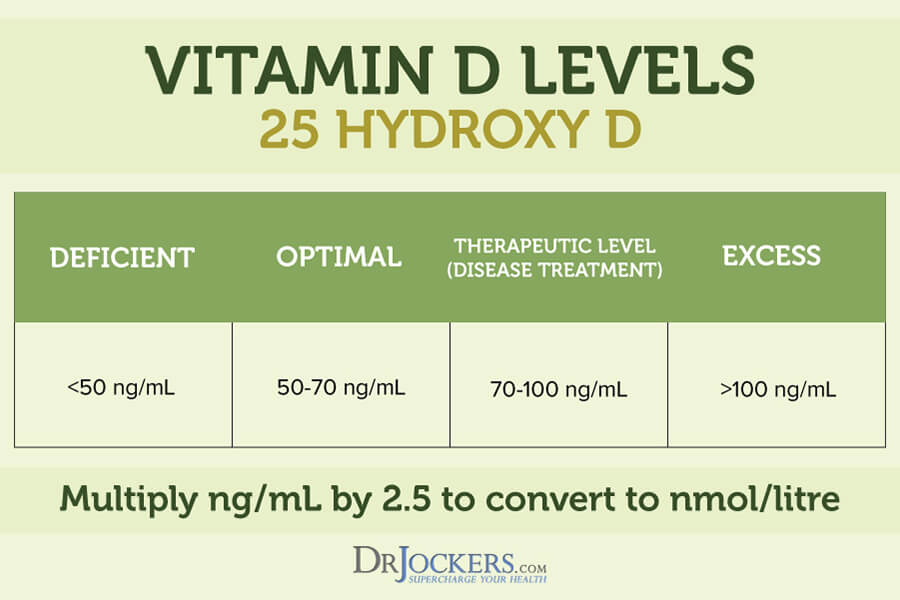
Optimize Zinc Levels
A 1988 study published in World Review in Nutrition and Dietetics, a 2006 review published in the Journal of Dermatological Treatment, and a 2019 case-control study published in the Turkish Journal of Medical Sciences have all found that zinc deficiency is common in those with dandruff and supplementation may help (20, 23, 24).
I recommend eating lots of zinc-rich foods, including grass-fed beef, oysters, eggs, chicken, spinach, kale, pumpkin seeds, hemp seeds, pine nuts, and mushrooms. I also recommend daily supplementation with a high-quality zinc supplement, such as Zinc Charge.
Increase Vitamin C & Polyphenols
A 1988 study in World Review in Nutrition and Dietetics has found that there are a variety of nutrient deficiencies that may play a role in some of the major causes of dandruff, seborrheic dermatitis and psoriasis, including vitamin C deficiency (20). Improving your vitamin C levels may help. You may do that by eating foods rich in vitamin C, such as lemon, lime, grapefruits, oranges, berries, pineapples, bell pepper, broccoli, cabbage, and tomatoes. You may also supplement with vitamin C, such as Super C.
Vitamin C and other polyphenols may also help to reduce skin inflammation that may contribute to dandruff. Moreover, a 2011 randomized controlled trial published in Acta Verna-Dermatologica has found that histamine intolerance was twice more common in those with dandruff than those without (19). Quercetin and resveratrol may help to reduce inflammation and histamine intolerance.
Quercetin is a plant flavonol that naturally helps to reduce histamine levels, decrease allergic response, and support your immune system. Quercetin is found in various plant foods, such as cranberries, blueberries, chokeberries, black currants, black plums, cherries, apples, grapes, cruciferous vegetables, red leaf lettuce, romaine lettuce, cabbage, hickory greens, kale, asparagus, snap peas, red onion, peppers, sprouts, various herbs, and olive oil.
Resveratrol is a polyphenol with anti-inflammatory and antioxidant benefits. It is found in the skin of red grapes, red wine, certain berries, pistachios, and cacao. Quercetin and resveratrol complement each other in benefits and are often used in combination. Besides consuming quercetin- and resveratrol-rich foods, I recommend supplementing with Resveratrol Power. This supplement is a great source of both quercetin and resveratrol. It helps to support your skin health, mitochondrial health, immune function, and circulation and may help to reduce oxidative stress when used daily.
Topical Coconut Oil on Scalp
If you have dandruff, there are several natural topical treatments that you may try to reduce your symptoms and decrease the risk of flare-ups. One of these options is using topical coconut oil on your scalp. A 2007 study published in the Journal of Medicinal Food has found that coconut oil offers antimicrobial properties and may reduce fungal growth (25). A 2017 study published in Advanced Pharmaceutical Bulletin has found that coconut oil offers anti-fungal benefits (26).
By reducing microbes and fungal overgrowth, coconut oil may help to reduce fungus-related dandruff. It may also help to reduce dry skin and inflammation. According to a 2021 study published in Science Reports, using topical coconut oil on the scalp for 12 weeks has helped to reduce microbes and improve skin health in participants (27).
According to a 2008 randomized controlled trial published in Dermatitis, extra virgin coconut oil may help to reduce fungal overgrowth and dryness (28). A 2010 study published in Pharmaceutical Biology has found that extra virgin coconut oil may help to decrease inflammation and pain, which may help symptoms of psoriasis, dandruff, and other skin concerns (29).
Apply coconut oil topically directly to your scalp. Massage it and comb through your hair to benefit the rest of your hair and reduce dry, brittle hair. Leave it on for several minutes allowing the coconut oil to fully penetrate your scalp and your hair. Rinse it off well. It is usually best to use this strategy instead of shampoo and conditioner. You may wash your hair with natural shampoo at another time as needed.

Topical Olive Oil Treatment
Topical olive oil treatment may also offer anti-fungal properties and may help to reduce inflammation related to dandruff and skin issues. According to a 2008 randomized controlled trial published in Dermatitis, topical extra virgin olive oil may help to reduce fungal overgrowth and dryness (28).
A 2017 review published in Molecules has found that topical olive oil treatment may have some moisturizing effects (30). This may reduce dryness, inflammation, and dandruff flakes. According to a 2012 review published in the Archives of Pediatric and Adolescent Medicine, topical olive oil treatment may help to address seborrheic dermatitis and reduce related dandruff in children (31).
To use olive oil to treat dandruff:
- Heat some extra virgin olive oil until it is slightly warm.
- Massage it into your scalp.
- Wrap your hair in a warm towel and leave it on for about 45 minutes.
- Wash it off by shampooing and conditioning your hair with natural products.
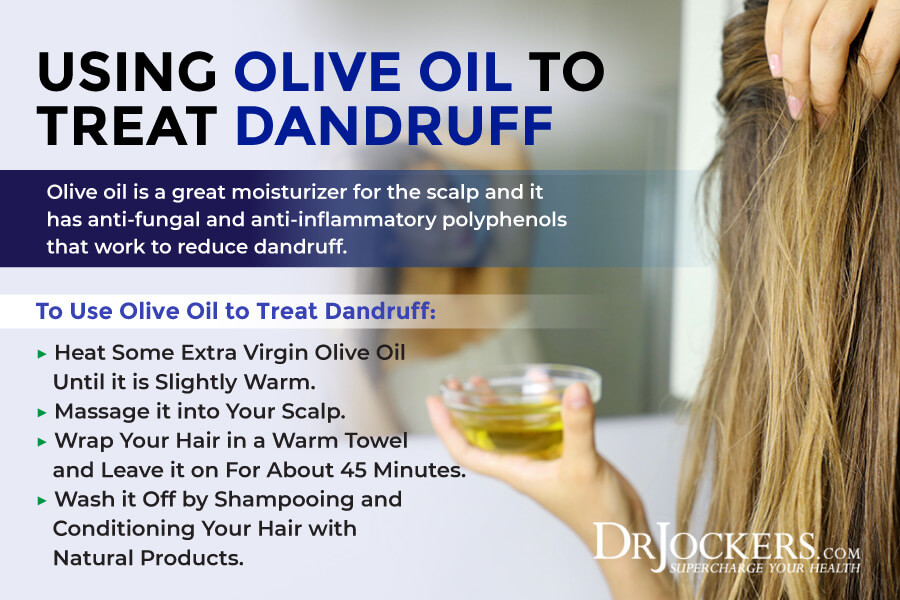
Rosemary & Tea Tree Oil Dandruff Hair & Scalp Mask
Rosemary is often used as natural hair care. People commonly use rosemary oil water rinse as a conditioner. Rosemary oil may also work as a mask and may help with dandruff. According to a 2021 study published in the Journal of Pharmaceutical and BioSciences, rosemary oil may help to reduce dandruff (32).
Tea tree oil may also help to reduce inflammation, skin issues, and dandruff. A 2002 study published in the British Journal of Dermatology has found that tea tree oil may help to reduce histamine-induced skin inflammation (33). According to a 2002 review published in the Journal of American Academy of Dermatology, using 5 percent tea tree oil topically in shampoo may help to significantly reduce dandruff (34).
Honey may also offer anti-inflammatory and antimicrobial properties that may offer some benefits for dandruff. A 2013 study published in the Iranian Journal of Basic Medical Sciences has found that honey may reduce fungal overgrowth (35). A 2001 study published in the European Journal of Medical Research has found that honey may be beneficial for seborrheic dermatitis and dandruff (36).
To experience the benefits of rosemary oil, tea tree oil, honey, coconut oil, and olive oil, I recommend this scalp mask. This recipe makes enough for two to three applications. You can double the recipe and store it in an airtight container for up to 10 days.
Ingredients:
- 12 drops rosemary oil
- 8 drops tea tree oil
- 1 teaspoon local honey
- 4 ounces olive oil or coconut oil
Directions:
- Blend ingredients well in a container.
- Massage into the scalp.
- Leave on for at least 20 minutes.
- For severe conditions, try leaving it on overnight.
- Shampoo well.
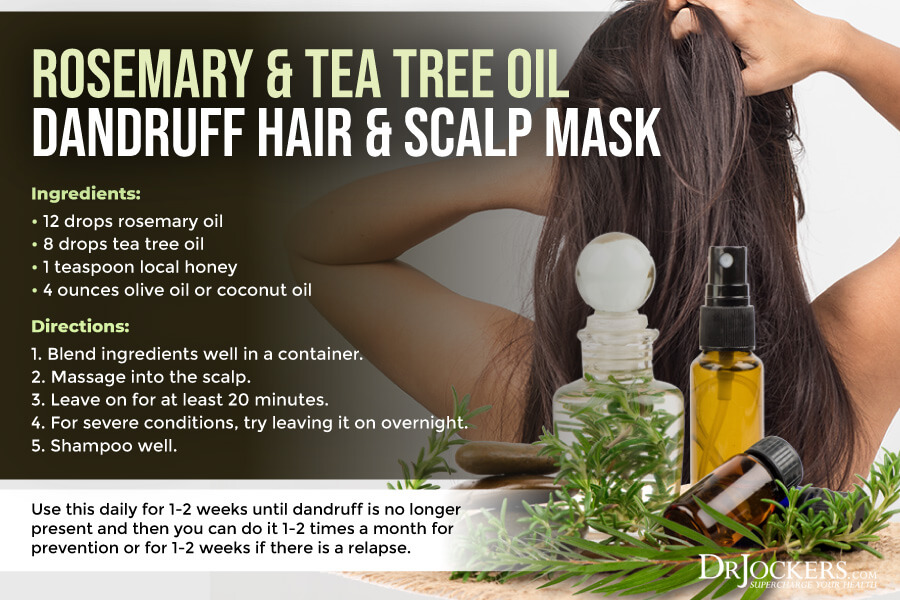
Final Thoughts
Dandruff is a skin condition that causes white or yellow dry skin flaking off your scalp. It can be a rather uncomfortable condition characterized by itching. It may also become embarrassing or frustrating due to the visible white flakes on your hair and clothing. The good news is that you don’t have to deal with the discomfort and embarrassment of dandruff anymore. I recommend that you follow my natural support strategies for dandruff to improve your health and well-being.
If you want to work with a functional health coach, I recommend this article with tips on how to find a great coach. On our website, we offer long-distance functional health coaching programs. For further support with your health goals, just reach out—our fantastic coaches are here to support your journey.




